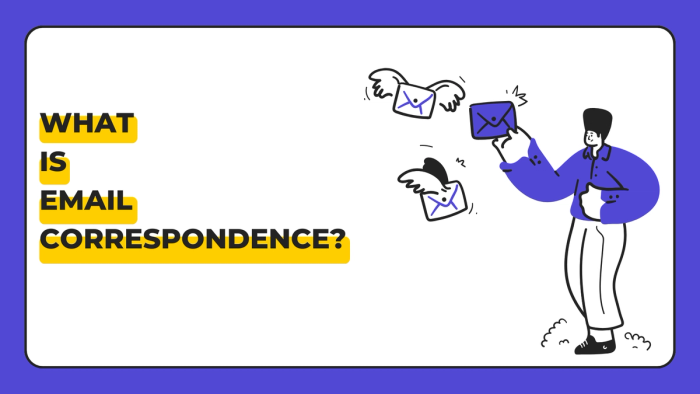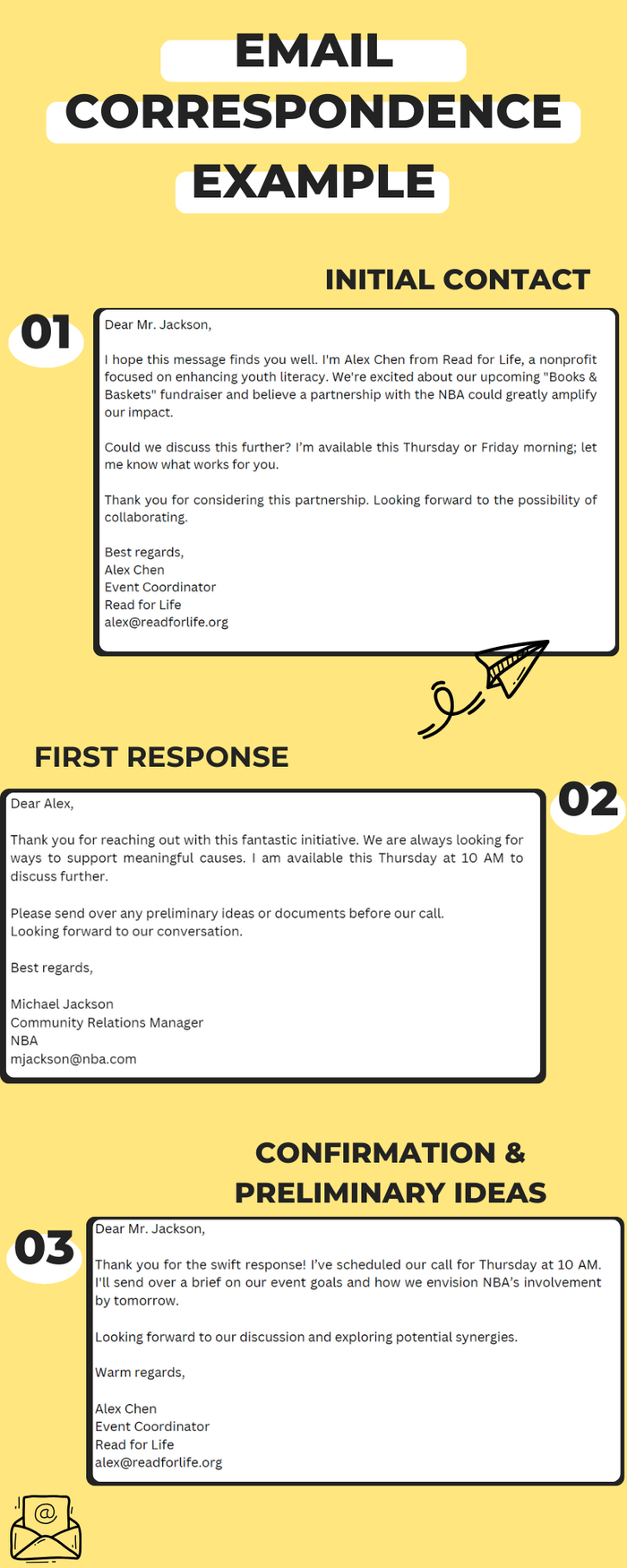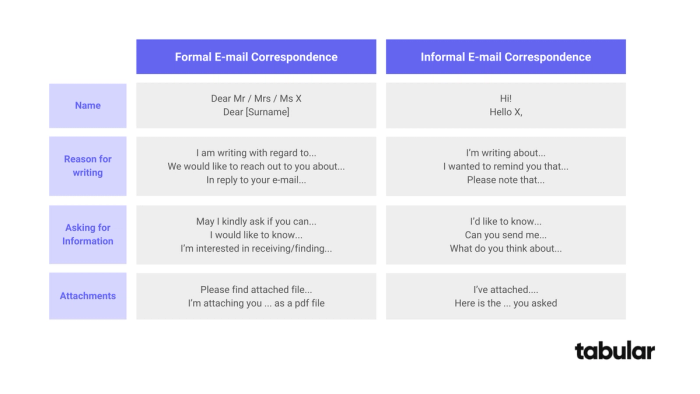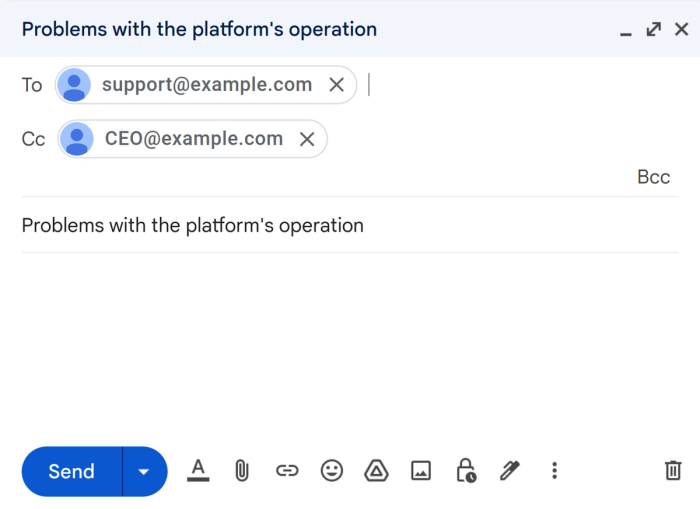Email Correspondence
Table of contents
- What is Email Correspondence?
- Establishing the Right Etiquette for Email Correspondence
- Email Marketing vs. Email Correspondence
- Email Correspondence Examples
- Benefits of Effective Email Correspondence to Your Business
- Important Components of Effective Email Correspondence
- Writing Professional Email Correspondence
- Email Correspondence in Legal and Business Contexts
- Conclusion
Email correspondence refers to the exchange of emails between individuals or groups.
The term "correspondence" in "email correspondence" emphasizes the ongoing back-and-forth nature of communication that happens via email.
Email correspondence involves multiple messages sent back and forth between parties. It isn't just about a single email; it's about a series of emails that form a conversation or a thread.
This ongoing exchange allows for detailed discussions, negotiations, and the building of relationships over time. Why is it important? In professional settings, email correspondence often follows formal structures and conventions to maintain clarity and professionalism.
And is it legally binding? Well, just as with paper correspondence, emails provide a written record of communications, which can be used for legal reasons, for maintaining business records, or for personal reference.

Communication channels are constantly evolving, just like everything else. For example, while lovers in the past exchanged letters, today they might flood us with unanswered Instagram Reels.
However, each communication channel comes with its own etiquette and expectations. Email correspondence is exactly that—knowing how to communicate appropriately in every situation.
If you’re engaging in any kind of email communication with colleagues, professors, classmates, or anyone in your professional life, it’s essential to understand the responsibilities of email correspondence. Since it is often considered a formal and documented form of communication, learning proper email etiquette is a valuable investment in your career.
In this article, we will offer a guide for future email correspondence. So, if you've ever wondered how to craft a professional email, we aim to address all your questions here.
What is Email Correspondence?
It’s always a good idea to begin with the fundamentals. The definition of email correspondence refers to replying to or maintaining ongoing email exchanges and continuing a conversation thread.
Do you think Ray Tomlinson ever followed up on an email or added someone to the loop? Since Ray Tomlinson’s first email in the 1970s, a lot has changed in the language and how we interpret it. This semantic evolution brought new categories into the language in a contextual manner and evolved email into the most respected written communication channel.
We now have different words like "boo" or "bae" to communicate with our partners, and we use phrases like "no cap" between friends. These may all vanish and be replaced by new phrases and words in the future.
Just as in any other area where diverse people gather for a common purpose, office environments and different social contexts contain respective jargons and slang words. Email correspondence is all about knowing what to say, when, and where.

Now that we've covered the meaning of email correspondence, let’s dive into the key question: What should you pay attention to when writing an email correspondence?
Establishing the Right Etiquette for Email Correspondence
In any form of communication, it’s crucial to gauge the situation to ensure you're communicating appropriately.
When sending a business correspondence email, it’s important to prioritize professionalism, timeliness, and clarity. All the different components of an email need to be aligned with the context and your goal.
These aspects are particularly important when corresponding with a supervisor or higher-ups.
- Avoiding Typos and Mistakes: Small mistakes can happen, but thorough proofreading can help you catch errors. Double-checking names, email addresses, and grammar will ensure your correspondence emails are polished.
- Tone and Formality: The appropriate tone and level of formality depend on who you are addressing. Not all correspondence emails require strict formality. For instance, when writing to a colleague or classmate, a friendly tone is acceptable. However, when writing to a business partner, client, or superior, avoid humor or sarcasm that might be inappropriate. Knowing how to write your email, from the greeting to the signature, is crucially important for leaving a good impression.

Email Marketing vs. Email Correspondence
When communicating via email, the primary goal is to exchange information between two counterparties. However, the nature of this information can shift the type of engagement. Email marketing leverages these communication techniques to capture customer interest and generate leads using email software such as Moosend and Brevo. The focus is often on promoting a product or service while communicating through email. When crafting a marketing email, you're speaking from the perspective of a brand, emphasizing its priorities and values.
Since the key objective is to promote a product when building an email marketing email, the content is tailored to align with the recipient's interests and needs. Typical recipients may include patients, customers, employees, business partners, and investors.
On the other hand, email correspondence adopts a more genuine, communicative tone. It typically centers on activities such as public and media relations, internal communications, and managing relationships with members and stakeholders.
Business email correspondence is aimed at fostering trust, credibility, and a collaborative environment. It seeks to establish a dialogue where both the sender and the recipient can express their points in a one-on-one setting. Thus, the language nuances between marketing emails and professional email correspondence reflect the different purposes and approaches of these communication types.
Email Correspondence Examples
Email Correspondence Example Between Boss and Employee
Hi [Employee’s Name],
I hope you’re doing well. Could you please provide me with a quick update on the XYZ project? We need to make sure everything is on track before our meeting with the client next week.
Let me know if there are any challenges or additional resources you might need.
Best regards,
[Boss’s Name]Hi [Boss’s Name],
Thank you for asking. I’ve made significant progress on the XYZ project. We have completed the initial design phase and are now working on the development stage. I will send you a detailed report by the end of today, as requested.
So far, everything is on track, but I will reach out if I encounter any issues.
Best regards,
[Employee’s Name]Hi [Employee’s Name],
Thank you for the quick update. I appreciate your hard work and attention to detail. I’ll review your report once it’s sent, and we can discuss any further steps if needed.
Keep up the great work!
Best,
[Boss’s Name]Email Correspondence Between Colleagues Deciding What to Wear for an Event
Hey [Colleague 2’s Name] and [Colleague 3’s Name],
I was wondering if you both have any thoughts on what to wear for the office event on Friday. Are we going for something formal, or is it more business casual? Let me know your thoughts!
Looking forward to it!
[Colleague 1’s Name]Hi [Colleague 1’s Name] and [Colleague 3’s Name],
Good question! I’m leaning towards business casual since it's not a super formal event. Maybe a nice blouse and slacks or a simple dress could work. What do you both think?
Best,
[Colleague 2’s Name]Hey [Colleague 1’s Name] and [Colleague 2’s Name],
I agree with [Colleague 2]. Business casual sounds perfect. I’m thinking of wearing a button-down shirt with dress pants. Can’t wait to see you both there!
Cheers,
[Colleague 3’s Name]Benefits of Effective Email Correspondence to Your Business
Since we've already covered the meaning of correspondence emails, let's now explore the advantages of incorporating them into your business. By implementing this communication technique in your business strategy, you'll gain several benefits.
We've outlined these benefits to provide a clear overview of how professional email correspondence can enhance your business operations. Here's a look at what you can achieve with it.
- Immediate Outreach: Business correspondence email enables swift and efficient communication with customers. By using formal email correspondence, you can establish connections and build long-term relationships. Since emails land directly in the recipient's inbox, you can communicate quickly while maintaining a documented exchange.
- Geographical Reach: With the growth of digital media, businesses are no longer limited to local markets. Email correspondence transcends geographical boundaries, allowing you to communicate with customers globally. Beyond just selling, it opens doors to establishing partnerships with companies from around the world.
- Accessibility: The email correspondence format is accessible to anyone with an internet connection. While not everyone may be active on social media platforms, nearly everyone has an email address. This makes email correspondence a highly accessible communication method.
- Builds Customer Trust: While acquiring new customers is important, building long-term relationships is even more beneficial. Satisfied customers can lead to word-of-mouth marketing. By starting with cold emails, you can gradually cultivate trust and create lasting customer relationships.
- Encourages Useful Feedback: Email correspondence fosters interactive communication, allowing customers to provide feedback. This feedback can help you improve the customer experience, and by responding to it, you demonstrate that you value their opinions.
- Ideal Platform for Storytelling: In business correspondence emails, even though they are professional, you can still adopt a genuine tone. Incorporating storytelling elements allows you to share details about your products, such as the manufacturing process or usage scenarios. Storytelling is a powerful tool for boosting customer engagement and encouraging dialogue.
- Enhances Brand Awareness: Sending reminder emails about special promotions, asking for feedback, or referencing their past purchases keeps your brand top of mind when they need your product or service.
- Improves Relationships: Business correspondence emails enable you to build and strengthen relationships with clients, partners, and employees. Whether forming new connections or nurturing existing ones, this type of email communication is vital for maintaining future correspondence.
Important Components of Effective Email Correspondence
Subject line: The subject line in an email correspondence format is like the cover of a book or the display window of a store. It’s the first thing that the recipient sees, along with your email address and opening line.
Therefore, crafting an attention-grabbing and concise subject line is crucial to capturing interest.
Greetings and Sign-Offs: First impressions and farewells are significant, and sometimes they’re the most memorable aspects of a brief business interaction.
To leave a lasting impact, using the appropriate email greetings and sign-offs is essential. It’s particularly important to differentiate between formal and informal email correspondence when choosing these elements.
For email greetings, addressing recipients by name is a great way to capture attention and create a more personal connection. You could use options like:
- Hello
- Good morning
When it comes to sign-offs, after delivering your main message and including any call-to-action, the right closing can reinforce professionalism and encourage continued engagement. Examples include:
- Best regards,
- Sincerely,
Carbon Copy (CC) and Blind Carbon Copy (BCC): In some cases, you may need to include additional people in the conversation for clearer communication. For example, in business email correspondence, if you want to elevate the discussion to a sales conversation, you might use carbon copy (CC) to keep others in the loop.

Alternatively, if certain participants need to observe the exchange without being visible to others, you can use blind carbon copy (BCC). This allows added participants to stay informed without the primary recipient knowing.
However, it’s important to use CC and BCC appropriately in formal email correspondence. Always be transparent when involving a third party in the conversation, and avoid adding someone without notifying the original recipient. Additionally, if you do CC or BCC someone, provide them with a brief summary of the conversation to help them get up to speed quickly.
Writing Professional Email Correspondence
After covering the basics of formal email correspondence, we can now move into the practical steps. Here are key considerations for writing professional email correspondence.
- Be Concise: The reason email correspondence is so widely used is that it saves time for both the sender and the recipient. Keeping the email body clean, short, and to the point is essential. This prevents your message from drifting away from its main objective. You can apply visual hierarchy techniques to organize your text for easier readability.
- Remember who you are writing to: While email marketing often speaks from a brand’s perspective, email correspondence involves a human-to-human interaction. It’s important to remind the recipient that this is a genuine conversation. By empathizing with the recipient, you can maintain a polite and respectful tone throughout the communication.
- Be clear with what you expect from the reader: In today’s world, attention spans are limited. It’s crucial not to confuse the reader or make them guess your intentions. Maintain a clear structure and tone to effectively convey your email's purpose.
Email Correspondence in Legal and Business Contexts
In legal contracts, email correspondence is defined as the exchange of written communication via electronic mail between two or more parties.
This communication is subject to strict privacy and security regulations, such as the General Data Protection Regulation (GDPR) in the European Union or the California Consumer Privacy Act (CCPA) in the U.S., designed to protect personal data.
Under these secure communication policies, all parties involved have a legally documented conversation that can only be shared within the bounds of agreed-upon transactions. To safeguard against unauthorized access or breaches, measures like encryption should be applied to ensure the security of email correspondence.
In business email correspondence, it’s essential to obtain consent from clients for non-transactional communications, making sure all email exchanges comply with privacy laws.
Building long-term relationships with customers requires attention to legal compliance, which helps protect both your company and your clients from potential legal and reputational risks.
Conclusion
Email correspondence should have a natural and authentic tone. To summarize, a well-thought-out structure is key to a successful email. While adhering to email etiquette, remember to properly address the recipient, provide a clear subject line, and maintain a concise body with an appropriate sign-off.
Lastly, keep in mind that you're not representing a company but yourself as a person. By maintaining a friendly and sincere tone, you can build trusting and lasting relationships.